A week into DreadTober 2017, and it is time to show some progress. The week started with finalizing the pose and gluing down the last bits where I was using mounting putty to hold things together. New mounting putty went over any remaining areas where I plan to glue parts following priming and painting. The only exception was the head. Since it will be pinned and sits well down in the armor collar where it can't reasonably get knocked about, I see no reason not to apply a simple drop of super glue to the pin when dropping the head in at the end. I'm even considering some fancy pinning to allow the head to be mounted firmly and still turn left and right for fun...we'll see. The head and sword are mounted on old bourbon bottle corks since I expect to handle them a bunch during painting. By contrast, I expected to mount the other parts fairly quick, or at least to handle them very little before they are mounted and the final paint applied. So they are not put on cork handles. I may come to regret that later.
With the pose set, all the bling added, and the parts set for painting it was time to throw on a good coat of primer. For this model, I am choosing to go with a coat of Vallejo Primer Black shot through the air brush. This method is my new favorite for priming. I do have a small spray booth with a fan vented to the outside, but even with this, the use of standard rattle-can primer smells up the beats lab, and then eventually the first floor of the house which does not please the family...Happy family; happy hobby!
Spraying outside is the go to, obviously, and I do this for all my large projects like terrain...but as we all know, this is very weather dependent. In the US northeast, I can't count on many dry, temperate days for this. It is mostly humid and when it isn't humid or raining it's either too hot or too cold. The air brush and a spray booth with outside venting comes to the rescue and allows me to prime anythign anytime. The Vallejo primers cover well, pass through my Iwata Eclipse with no issues and stay stuck on in my experience. They leave a good paintable finish and offers little to know smell when shot through the air brush.
With the pose set, all the bling added, and the parts set for painting it was time to throw on a good coat of primer. For this model, I am choosing to go with a coat of Vallejo Primer Black shot through the air brush. This method is my new favorite for priming. I do have a small spray booth with a fan vented to the outside, but even with this, the use of standard rattle-can primer smells up the beats lab, and then eventually the first floor of the house which does not please the family...Happy family; happy hobby!
Spraying outside is the go to, obviously, and I do this for all my large projects like terrain...but as we all know, this is very weather dependent. In the US northeast, I can't count on many dry, temperate days for this. It is mostly humid and when it isn't humid or raining it's either too hot or too cold. The air brush and a spray booth with outside venting comes to the rescue and allows me to prime anythign anytime. The Vallejo primers cover well, pass through my Iwata Eclipse with no issues and stay stuck on in my experience. They leave a good paintable finish and offers little to know smell when shot through the air brush.
Before setting about painting the primed model, I put in a little work on the base. All the cork pieces were glued down with wood glue (I find this adheres and lasts well over standard white glue, but it is probably not really necessary). Then some plastic daemon skulls were added from the new GW skulls boxed set. These are Daemonhunters after all! Some random fine ballast was glued around here and there to fill in bits and make the cork ledges a come off a bit more realistic with crumbly sections, etc. Then I spread Vallejo Black Lava over all the flat cork surfaces to give everything a dirty, dusty look and conceal the very obvious cork surface patterns. Lastly I glued on some random large and medium rocks . These hopefully add some variety and a more natural rugged feel to the terrain. Here are some pics of the result.
In the top left and middle right you might just make out the dreadknight's foot prints. While the black lava was still wet, I pressed the legs down firmly, but carefully to get a bit of an impression. This will help remind me where I want to pin the legs down later and also adds a bit of weight to the model when all is finally assembled. It will be subtle but the feet, especially on the left leg, should appear to be sinking in and kicking up a bit of the hard-packed earth as the Grand Master strides forward. Perhaps a bit of this shows below with the legs temporarily in place for scale.
With the base complete and put aside to dry, it was time to get some painting in. I started by laying down the metallic base colors on the dreadknight with the air brush. A solid coat of Vallejo Air Gunmetal was sprayed all over, with particular attention the getting it in and around all of the leg framework. Then a coat of Vallejo Oily Steel was applied top-down at a roughly 45 degree angle to add highlights. Last, some Vallejo Steel was added primarily to armor panels and key highlights at the top of the model and a few spots I thought would catch more light. I then put some white down on the left shin armor where the Grand Master's personal heraldry will go. I'm thinking that I'll brush paint the right shoulder armor with the same heraldry as well. Too fussy to try to air brush that now with the pistons and what not in the way...at least for my airbrush skills! :)
With the base colors in place, it was time for the GW Nuln Oil Gloss wash. This was basted liberally over the whole model with a large brush focusing on areas with deep detail. On the armor panels, I used a second brush, wet with water only, to pull off any wash pooling badly and even on a few other spots that looked shabby. Not a perfect effort, but I'll have much less tidying up to do once the wash is fully dry. Here's some shots in the light box of the results. Coming along nicely, I think.
While the wash dried, I put some more work in on the base. Vallejo German Camo Black Brown (70822) was laid down with the air brush under and around the rough edges of the cork and in the valleys between the raised pieces. This will provide deeper shadows around these areas. Next another lighter Vallejo brown (there are so many, I forget what I used) was air brushed all around the top edges of the cork, a bit among the highest flat surfaces and a bit on the largest open flat areas to the front of the base, and dusted over the skulls for effect. This base work is an organic process for me and not a precise, planned effort. Last for the browns, a Vallejo Green Brown was applied just to the edges of the cork pieces and skulls as a final pre-shade highlight. Lastly, Vallejo German Grey was applied to the large rocks and similar gravel to off set these from the cork and other gravel bits.
Then the whole base was given an all over coat of GW Agrax Earthshade, followed by spot washes of GW Athonian Camoshade (all the grey rocks and gravel areas) and Carroburg Crimson here and there for interest while everything was still wet. I'll see how this comes out once dry. I'll be doing some dry brushing for certain. I'm also thinking of adding a clump of grass or two. The daemon skulls will of course get picked out in a light color for contrast. The rim of the underlying plastic base will get a fresh coat of GW Abaddon Black once this all dries to tidy it up. A simple but effective piece of ground I hope.
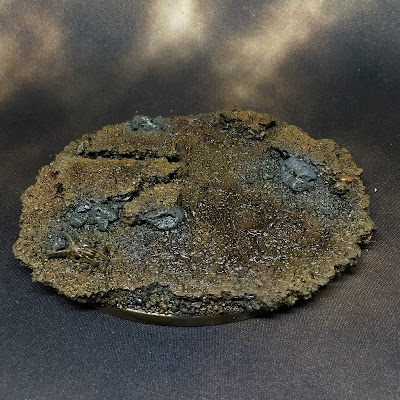 |
| The base with washes applied, still wet. |
Well that's what I have for now. I'm enjoying the progress shown by other challengers. Some great pieces coming along for this years event. Stay tuned for week 2 progress and possibly a post on the WIP Deathwatch Captain with Jump pack that is still waiting to get finished.
Cheers and Happy Gaming!

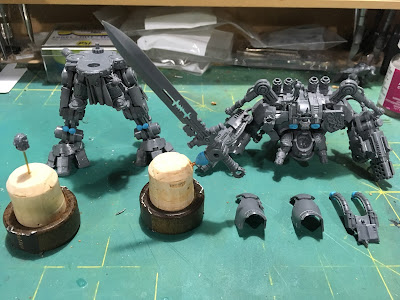

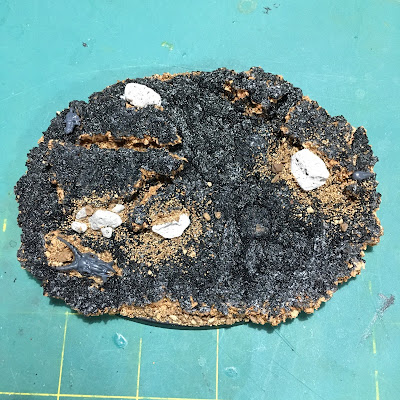


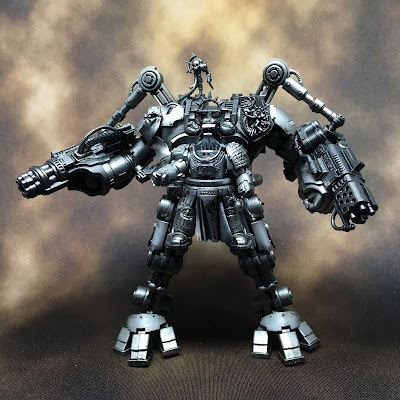
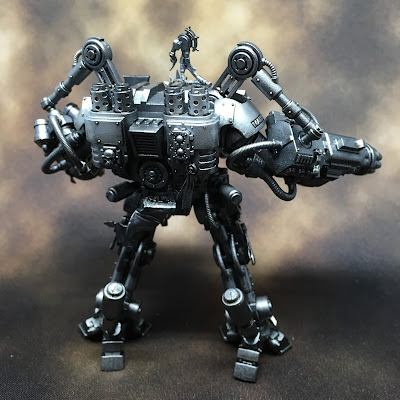
That's looking really cool already! I do have a question though, have you really noticed a huge difference by keeping your gluing points bare plastic? I must admit I tend to assemble most of my models before priming, but I hadn't noticed a difference in adhesion where I'm gluing painted pieces using the GW poly glue.
ReplyDeleteTo be honest, I've done this for so long now that I forget how things were exactly before. What I recall is some brittleness in some joints that would leave parts coming off more easily. Super glue often held, but the paint underneath let go and chipped off, and the plastic cement doesn't hold unless it can melt/weld bare plastic together. With thin pint, I imagine that the plastic cement might cut through the paint and result in a partial weld. I just know I ended up with fewer parts coming off and the "new" technique I started using just seemed to make sense from the gluing standpoint. It may well be that it isn't truly worth the effort, in fact. But I've done it this way for well over a decade at this point! :) I could easily have been no cleaning and priming my models well in the past (so the paint was "loose")...or using crappy glues...I've made so many changes in product and method.
DeleteThat’s great progress, shaping up nicely. I mask or file to remove paint when I join bits too, I find if you only use Poly Cement sparingly it melts the paint fine but then only partially does the intended weld. If I use superglue, all I’m really gluing is the layer of paint, so removing this to expose the surfaces to be fixed makes sense to me.
ReplyDeleteThank you!
DeleteGreat progress so far, and I love the detail you went into about your modelling choices. I’ll try add some of that context to my own posts in future
ReplyDeleteThanks! I write to remind myself how I did certain things and why as much as I do to share with others. I don't feel so accomplished in my hobby that I'm comfortable putting out true "how-to" material - there's so much of good quality available already. But hopefully something I found easy or useful might also help another out there in the 'verse.
Delete